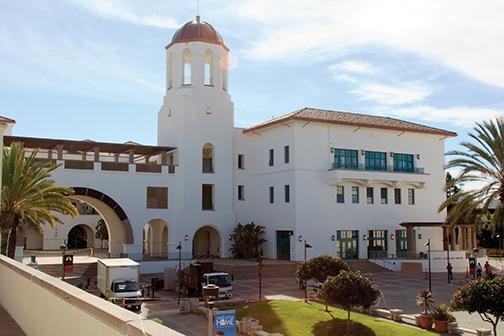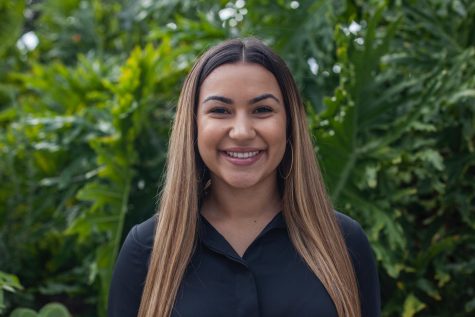Center for Intercultural Relations Police Officer Office Hours
Chief Josh Mays addressed recent student concerns regarding the San Diego State Police Department’s proposal to hold office hours in the Center for Intercultural Relations at the Associated Students meeting on Sept. 28.
“I am certainly aware of the national narrative about race and policing,” Chief Mays said.
He apologized and said there was a discrepancy between his intentions for the office hours and how they came across to the students.
“My intent was not to offend,” he said. “It was to create an opportunity where student and officer interaction was occurring in a safe place.”
Chief Mays said the purpose of the office hours was to increase positive interaction.
“We are working to think of how we can find out the best way to do that,” he said.
Chief Mays said student affairs, the CIR and the police department will make the final decision regarding if or how the office hours will continue.
A student asked if there could be rotating officers at the office hours.
Mays said part of the challenge to having different officers at each of the office hours is limited resources.
After he talked about the police department’s issues with CIR, Chief Mays allowed students to ask him questions.
In regards to the Marquis Campbell arrest, Chief Mays said no matter what he is talking about, he can never tell the whole story because some private information cannot be shared with the public.
“Part of the problem is that when I can’t tell the whole story, it looks distrustful,” he said.
Chief Mays explained the legal process of an arrest.
When an officer responds to a call, if that officer has probable cause to make an arrest he can make an arrest without a warrant based on things such as observations and probable cause, he said.
The officer can book a person for whatever they have evidence of. That person then remains in custody from field arrest and a judge reviews the evidence.
If the judge disagrees and finds a mistake in the arrest, that person is released. The judge then signs off and if the person is eligible for bail they can do so. If they post bail, they are promising to return for their trial.
Marquis’ trial is Oct. 6 and his bail is set at $20,000.
“I understand why the public wants to know what the evidence is,” Chief Mays said. “My response is to go to court on Oct.6 where you can see absolutely everything that the DA is bringing before the court to say this is why we are continuing charges against Marquis.”
Marquis’ arraignment will be on Sept. 26. The district attorney will continue to pursue charges if they are certain that they can prove beyond reasonable doubt to a jury that the person the officers arrested is guilty of charges. If not, the DA will say that they decline prosecution.
“Marquis’ arraignment was upheld which means the new judge who saw the information supports the probable cause to move forward,” Chief Mays said.
Chief Mays said he has received many of the same questions about the case. In his discussion, he addressed many of them, formatted below as a Q&A.
Q: What is the evidence?
A: My answer to that is if I came in here drunk, you would know that I am drunk. No matter how hard I try.
Officers are trained to understand and deal with those that are under the influence of a controlled substance. Therefore, the court says that officers can make an arrest for someone being under the influence based on physical symptomatology.
California law says if a police officer makes an arrest for someone being under the influence, we draw your blood and have toxicology reports done. The report takes three weeks from the time of the arrest until the DA’s office receives the results.
I cannot speak of Marquis’ toxicology reports, but I can tell you that if we do the math the DA probably doesn’t have those results.
Q: How can he be charged with two counts of resisting arrest of an executive officer and two counts of resisting arrest and not for being under the influence, which is the initial reason he was arrested?
A: I cannot speak for the DA, but I can say that it is a common practice for the DA to do an add charge. Before trial, there is a preliminary hearing where a new judge examines all the evidence and makes sure everything was obtained legally, it was in accordance with the law and that there is a probable cause to continue holding whoever the defendant is accountable for trial.
At this time the toxicology report reveals what substances were in the blood. If the defendant has substances in his blood, the DA can do an add charge with scientific evidence. This usually doesn’t happen until the trial because of the time the toxicology report takes to be completed.
As an officer, if I already know that someone is under the influence of a controlled substance I am going to place him under arrest. There has to be a lawful reason to order someone to remain at the scene. In most cases, officers have already established probable cause for the arrest. In some cases it can be difficult because the officer knows they are going to put handcuffs on someone and the person begins to walk away.
From the bystander’s perspective, they are seeing someone walk away and not doing anything wrong. You have to examine what the police officer already knows based on the calls that are coming in and what they are seeing.
Yes, you can be arrested for resisting arrest. That might be the only charge because law across this nation says that when an officer tells you that you cannot leave, you cannot leave regardless of what you think and what your perception is.
You have to remain and listen to what the officer says. It is a violation of law to resist arrest.
Q: Why won’t President Hirshman and SDSUPD intervene?
A: After the arrest is made and the officers have booked someone in the county jail, it is no longer our case. It becomes the jurisdiction of the District Attorney of the county of San Diego.
President Hirshman, the university or myself cannot say we don’t want to press charges and have the charges dropped.
Q: Why did your officers use so much force to take him into custody?
A: I cannot speak of the specifics of that case because it is ongoing, but I can talk about the process and systems.
The amount of force that is used in any situation is based from a reasonable standard. That standard is throughout every court in the US and dictated and outlined by the Supreme Court. If unreasonable force is used the DA will not file the case.
If someone does not want handcuffs on them, it does not look pretty. It looks violent.
The safest method is to get people on the ground because most people are not trained to fight on the ground and officers are. Officers are also trained to dogpile people and ask for backup.
Marquis was uninjured. That is the goal.
I am not up here making excuses for what you have seen in the past or what your perception is from what you have seen on a video. I am trying to add context for your overall conversation and how you move forward.
Q: Why has there been more police presence on campus the past few weeks?
A: The first five weeks of the semester requires extra officers because of Aztec Nights and other events. There is a certain number of officers required to work. Our staffing remains the same on every shift, but it will fluctuate if there is a special event.
One of my directions to the officers was to spend time in our community. Part of that is getting a cup of coffee at Starbucks and walking around campus. I want them out and about so they are seen as a resource.
Student Success Fee
Jessica Robinson, assistant dean for health and human services, spoke about student success fee proposals.
Sixty three proposals were approved last year, including 9 out of 13 proposals from health and human services.
She said part of the reason four proposals weren’t approved was because they had spelling errors and because some of the advisors did not know the full details of a submission.
Robinson said proofreading these proposals is essential and encourages the groups to work with a faculty or staff advisor closely when making them.
In order to apply for this it must benefit more than two students and must be submitted by a San Diego State student.
Ten percent of the student success fee goes toward proposals, Robinson said.
The deadline to apply for the students success fee is Oct. 7 and the money received from the fee must be spent by May 15.
Editor’s note: This story has been updated to correct the fact that 63 proposals, not 13, were approved in 2015.












